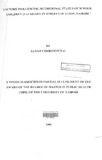| dc.description.abstract | Malnutrition is a major public health problem in Kenya. Fifty four percent of the children
under five years are malnourished out of which 30.6% are stunted, 4.8% are wasted, and
19.1% are underweight (CBS, MOH and aRC. Macro 2004). In view of the scale of the
problem in children under five years, nutritional programmes in Kenya since
independence have focused on this age group. However, malnutrition is a significant
problem in older children as well, a fact that is often overlooked by policy makers and
program managers (Kapoor et al 1999). This is despite the fact that malnutrition in
children under five years does not disappear magically when children cross the 'critical'
threshold of five years because there are many factors influencing their nutritional status.
The aim of this study was to establish factors influencing the nutritional status of school
children in Kieran Location, Nairobi. This was a descriptive cross sectional study
conducted in the four villages of Kieran Location, namely, Makina, Silanga, Kieran, and
Lindi. Multi-stage random sampling was used to select the study location. A pre-tested
structured questionnaire was used to collect data from 432 randomly selected households.
The questionnaire focused on socio-demo graphic, environmental, and food security
factors of the households and the frequency of food intake. In these households,
anthropometric measurements of the youngest school child between 5 and 14 years of age
were also taken using a Standiometer and Salter weighing scale.
The nutritional status of the school children was assessed using anthropometric indicators
of body mass index (BMI for age), weight-for-age (wt/age), and height-far-age (ht/age).
The data were entered and analyzed by use of SPSS version 11 and EPI info version 3.4.3
2007 Nutristat packages, and STRATA version 9.
A total of 432 children in the age range of 5-14 years were assessed. Out of the group
.studied, 44% were males and 56% were females. The prevalence of stunting among the
children was 35%; prevalence of underweight was 26.0%: prevalence of thinnessxv
was14.8 %, prevalence of overweight 7.1%; and obese was 6.3%. Girls were more
affected than boys. Younger children who were ages 5-7 years were also more affected.
Results of the bivariate analysis showed that many variables were significant but after
subjecting the data to logistic regression analysis to eliminate confounding factors, it was
found that only the care givers' level of education (p = 0.003) and consumption of less
than three meals per day were significant (p = 0.035) factors affecting the nutritional
status of the school children who were underweight. Eating less than three meals per day
(p = 0.031) was found to prevent overweight in the school children.
The main factors found to have a significant effect on the nutritional status of the school
children were the alternate care giver's level of education, and food consumption and
frequency patterns (particularly the frequency of meals per day). The study recommended
that efforts directed towards education of the alternate care giver and frequency of meal
intake per day would have a positive impact on the nutritional status of school children in
the study area. | en |

